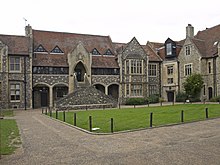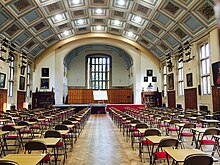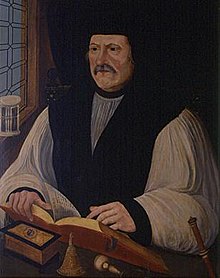inscribed and dated "Canterbury from the School Playground Fri Aug 21 1857" and signed with initials "TT"
Tom and Laura Taylor and thence by descent
The King's School is a public school in Canterbury, Kent, England. It is a member of the Headmasters' and Headmistresses' Conference and the Eton Group. It is Britain's oldest public school; and is arguably the oldest continuously operating school in the world, since education on the Abbey and Cathedral grounds has been uninterrupted since AD 597.
The school started as a medieval cathedral school said to have been founded during Late Antiquity in AD 597, a century after the Fall of the Western Roman Empire, by Augustine of Canterbury, considered the "Apostle to the English" and a founder of the English Church, thus making it arguably the world's oldest extant school. This is based on the fact that St Augustine founded an abbey (within the current school's grounds) where it is known that teaching took place.
When the Dissolution of the Monasteries took place, the school was re-founded by royal charter in 1541. A Headmaster, a Lower Master, and fifty King's Scholars were established and the name "King's School", was used for the first time, referring to King Henry VIII. Cardinal Pole moved the school to the Mint Yard and acquired the Almonry building, which was in use for over 300 years.
Throughout the next 100 years several former pupils achieved national recognition helping the school establish its reputation; these include the first headmaster, John Twyne, and Christopher Marlowe, William Harvey and John Tradescant the Younger. The buildings were improved and academic standards raised during the leadership of John Mitchinson and around this time the school became a "public school" with a national reputation.
When Canon John "Fred" Shirley became headmaster in 1935 the school was suffering from the effects of the depression. He managed the school's rapid expansion to around 600 pupils over the next 30 years, constructing further buildings in the precincts and helping the school survive the war-time evacuation. The school received a new Royal Charter from King George VI and Queen Elizabeth in 1946. During this time, the reputation of the school grew, helped by its academic and sporting successes.
The school was boys-only for almost 1400 years, until the early 1970s, when girls were admitted to the Sixth Form for the first time, and the school has been fully co-educational since 1990. The school is also the oldest charity in the UK.
In 2011, Rated as 'Good' by Ofsted. In 2017, the school was subject to its latest regular, independent inspection.The inspection team praised the "outstanding academic results" and the pupils' integrity, self-assurance, and "generosity of spirit". According to the Good Schools Guide, the school is "Highly successful, producing excellent results". The Guide also stated that "You need to be creative, academically able and hard-working, as everything moves fast here."
In 2019, 54% of pupils scored A*-A for their A-Levels examination, and in 2022, 72% scored A*-A for their GCSEs.
There are 16 houses at King's, 13 boarding and 3 day. Most are named after past headmasters or people of interest in the school's history, with the exception of School House, The Grange and Carlyon. The Houses of the School are:
- School House: founded 1860 (boys boarding)
- The Grange: founded 1928, moved to a new building in 2007 (boys boarding)
- Walpole: founded 1935, (girls boarding). Named after the novelist Sir Hugh Walpole (KS 1896–98)
- Meister Omers: founded 1936, (boys boarding).
- Marlowe: founded 1936, (mixed day). Named after the poet and dramatist Christopher Marlowe (KS 1579–81)
- Luxmoore: founded 1945, (girls boarding). Named after Sir Arthur Fairfax Coryndon Luxmoore (KS 1889–93), Lord Justice of Appeal
- Galpin's: founded 1952, (boys boarding). Named after The Reverend Arthur Galpin, Headmaster from 1897 to 1910.
- Linacre: founded 1953, (boys boarding). Named after Thomas Linacre, founder of the Royal College of Physicians
- Broughton: founded 1976, (girls boarding). Named after William Broughton (KS 1797–1804), the first Bishop of Australia
- Tradescant: founded 1976, (boys boarding). Named after John Tradescant (KS 1619–23), the distinguished gardener and collector.
- Mitchinson's: founded 1982, (mixed day). Named after John Mitchinson, Headmaster 1859–73 and co-founder of the Headmasters' Conference.
- Jervis: founded 1992, (girls boarding). Named after Douglas Jervis OKS
- Harvey: founded 1996, (girls boarding). Named after William Harvey physician, who first determined the systemic circulation of the blood (KS 1588–92)
- Bailey: first founded 1990, (sixth form girls boarding). Named after Henry Bailey, second warden of St Augustine's College between 1850 and 1875 and an honorary Canon of the Cathedral
- Carlyon: founded 2005, (mixed day). Named after evacuation of the School to Carlyon Bay in Cornwall during the Second World War
- Lady Kingsdown House: founded 2015, (girls boarding). Named after Lady Kingsdown, Governor Emerita

- The Beerling Hall: Music and Drama Facility, part of the 13th-century friary, endowed by the late Donald Beerling and the Cantiacorum Trust
- Birleys Playing Fields: The School's sports grounds, located near the main site. A new pavilion was opened by David Gower on 17 September 2005
- Blackfriars: The Cleary Foundation donated the refectory of the 13th-century friary by the Marlowe Theatre as an art school and gallery.
- DT Centre: Design Technology & Engineering
- Edred Wright Music School: Music
- Field Classrooms: English and Mathematics
- Grange Classrooms :Mathematics, Religious Studies
- Harvey Science Block or Parry Hall: Biology, Chemistry
- J Block: Geography
- Lardergate: History and OKS Foundation
- Lattergate: Religious Studies and Headmaster's office

The Shirley Hall was built on the site of the tennis courts and opened by the Queen Mother in 1957. Assemblies, plays, concerts and public examinations all take place here. Underneath the Hall is the Pupils' Social Centre - The Malthouse: Victorian malthouse building now converted into a theatre, dance studio, dining hall, classrooms and rehearsal spaces
- Maugham Library: Named in honour of dramatist W. Somerset Maugham (OKS), whose ashes were scattered on the lawn nearby.
- Maurice Milner Memorial Hall: Fencing, Drama and Examination Hall
- Mint Yard Classrooms: Mathematics, ICT
- The Grange Yard Classrooms: three new classrooms built in 2017 in front of Shirley Hall. They are temporary buildings situated in a previously open space.
- The Old Synagogue at Canterbury: Music, Jewish Prayers. Built as a synagogue in 1847–8 by architect Hezekiah Marshall, the "Old Synagogue" is used as a recital hall by the music department and also used to host "Jewish Society". It is considered one of the finest buildings of the 19th century Egyptian Revival style.[10]
- Palace Block: a medieval building containing the Modern Languages Department
- Physics Block: Physics, Geology
- Pottery Room: Pottery
- Priory Block: Classics, English, Politics, Economics
- The Pupils' Social Centre: under Shirley Hall with a tuckshop, cafe, stationery Shop and Careers Centre
- The Recreation Centre: Gym, Hockey Pitches, Swimming Pool, etc. It is open to the general public on a membership basis.
- The School Library: contains over 25,000 volumes and offers access to the School Intranet
- Shirley Hall: School Assemblies and Examination Hall; formerly known as the Great Hall, renamed after the former headmaster, Fred Shirley
- St. Mary's Hall: Drama, Theatre Studies
- The Westbere Lakes: Sailing and Rowing

The school's Norman staircase is one of the most painted, photographed and admired sites in Canterbury. As its name suggests it dates back to the 12th century. For formal occasions, the School traditionally gathered here. Archbishops of Canterbury addressed the School from the Staircase during Visitations. King George VI, accompanied by Queen Elizabeth and Princess Elizabeth, presented the School's Royal Charter to the Dean on 11 July 1946.

- Purples: Until recently called 'monitors', these are the school prefects, who are marked out by their distinctive purple gowns. Only those in the highest year at the school may be a purple. Each house generally has one purple (the Head of House). The purples are headed by the Captain of School and a Vice-Captain. A head scholar and two Vice-head scholars are also invited to become Purples.
- Full Canterbury Dress: The name given to the school uniform, which consists of a white shirt with wing collar, black waistcoat, pinstripe trousers, black jacket, black socks, black tie and black shoes for the boys. Girls wear a white blouse, brooch, pinstripe skirt or trousers, black jacket, black tights and black shoes. When he came to the School, Fred Shirley, Headmaster (1935–1962), updated the school uniform to sports jackets but within a year, the boys had asked to revert to their traditional garb. He tried again after the War when the School returned to Canterbury, this time taking a vote on the matter but despite the difficulty in finding outmoded clothing in a time of clothes rationing, the boys once again decided to revert to tradition. In the mid-twentieth century, there were elaborate customs relating to such matters as buttons and the angle at which a boater was worn. The girls' version was introduced by Anthony Phillips, Headmaster.
- Court Dress: Worn on 'Commem Day', the last day of the school year, leavers wear court dress, consisting of white tie and black evening tailcoats, with breeches and black stockings. Purples wear their purple gowns and carry brown canes with gold handles while the Organ Scholars of the school wear black academic gowns over their court dress and carry black canes with Silver Handles.
- King's Scholars: An academically-select group, marked by black jumpers with white trimmings that have recently replaced their distinctive black gowns, they process wearing surplices during school services in the Cathedral. To become a scholar, a pupil must take the Scholarship examinations at a standard approaching GCSEs prior to entry at the age of 12 to 14 (Exhibitioners may also be elected) or, in the case of honorary scholars, achieve exceptional GCSE results (9 A*s is usually the minimum) or AS Level results. King's Scholars are part of the Canterbury Cathedral Foundation and have a role in the Enthronement of the Archbishop of Canterbury. Scholars are admitted by the dean at the beginning of every school term; the scholars kneeling before the dean, who then touches their head and utters 'Admitto Te', formally acknowledging them as a King's Scholar. King's Scholars in the Upper Sixth are permitted to wear a black gown.
- Uniform Gating: A form of punishment that requires pupils to wear Canterbury Dress all day every day, while getting a form signed by someone in a position of authority (usually a teacher or a purple) at 15-minute intervals during their free time. This can prevent them from leaving the school at all for up to a week.
- Monitors' Canes: A privilege given to School Monitors (Purples) and House Monitors. Purples are allowed black canes and House monitors are allowed wood coloured canes. The Head of the CCF is also allowed to carry a pace stick.

A festival of arts, held during the last week of the summer term, introduced by Fred Shirley in 1952. The week has featured over 100 events, ranging from classical concerts to theatre performances, held in locations around Canterbury. Events have been free to attend and required no booking and a number were broadcast live.

The week has culminated in Commemoration day (known as "Commem") on the last day of the school year when the school leavers in 6a wore court dress of white tie and tails, with breeches and black stockings, or their national dress, and the whole school attended a service to commemorate the school benefactors; such benefactors include Mathew Parker, the first Archbishop of Canterbury of Elizabeth I.
Main article: Independent school fee fixing scandal
In 2005, the Office of Fair Trading (OFT) provisionally found that the school exchanged detailed information about prospective fee increases with approximately 50 other prominent UK independent schools, including Eton and Sevenoaks. The OFT stated that "regular and systematic exchange of confidential information as to intended fee increases was anti-competitive and resulted in parents being charged higher fees than would otherwise have been the case."
Peter Roberts retired as Headmaster at the close of the Summer Term on Thursday, 7 July 2022. Elizabeth Worthington, Senior Deputy Head, is the interim head until September 2023 when Jude Lowson will become the first female Head in the history of the School
Notable headmasters
- 1525–1560: John Twyne[17]
- 1935–1962: Fred Shirley[18]
- 1975–1986: Peter Pilkington, later Lord Pilkington of Oxenford
Laura Wilson Barker (6 March 1819 – 22 May 1905), was a composer, performer and artist, sometimes also referred to as Laura Barker, Laura W Taylor or "Mrs Tom Taylor".
She was born in Thirkleby, North Yorkshire, third daughter of a clergyman, the Rev. Thomas Barker. She studied privately with Cipriani Potter and became an accomplished pianist and violinist. As a young girl Barker performed with both Louis Spohr and Paganini. She began composing in the mid-1830s - her Seven Romances for voice and guitar were published in 1837. From around 1843 until 1855 she taught music at York School for the Blind. During this period some of her compositions - including a symphony in manuscript, on 19 April 1845 - were performed at York Choral Society concerts.
On 19 June 1855 she married the English dramatist, critic, biographer, public servant, and editor of Punch magazine Tom Taylor. Barker contributed music to at least one of her husband's plays, an overture and entr'acte to Joan of Arc (1871), and provided harmonisations as an appendix to his translation of Ballads and Songs of Brittany (1865).
Her other works include the cantata Enone (1850), the violin sonata A Country Walk (1860), theatre music for As You Like It, (April 1880), Songs of Youth (1884), string quartets, madrigals and solo songs. Her choral setting of Keats's A Prophecy, composed in 1850, was performed for the first time 49 years later at the Hovingham Festival in 1899. The composer was present.
Several of Barker's paintings hang at Smallhythe Place in Kent, Ellen Terry's house.
Barker lived with her husband and family at 84 Lavender Sweep, Battersea. There were two children: the artist John Wycliffe Taylor (1859–1925), and Laura Lucy Arnold Taylor (1863–1940). The Sunday musical soirees at the house attracted many well-known attendees, including Lewis Carroll, Charles Dickens, Henry Irving, Charles Reade, Alfred Tennyson, Ellen Terry and William Makepeace Thackeray.
Tom Taylor died suddenly at his home in 1880 at the age of 62. After his death, his widow retired to Porch House, Coleshill in Buckinghamshire, where she died on 22 May 1905, aged 86.

